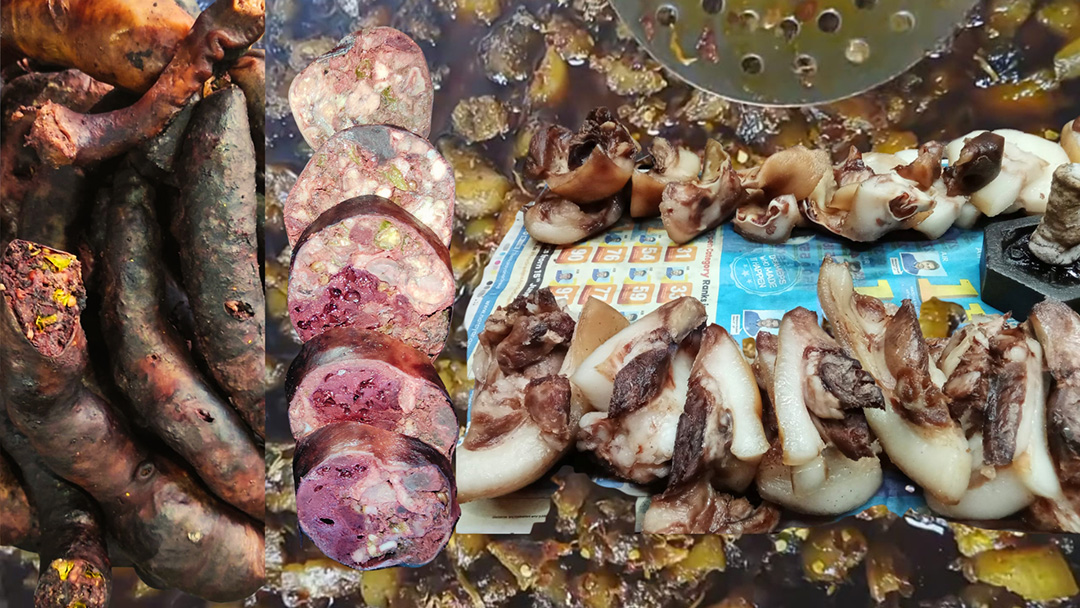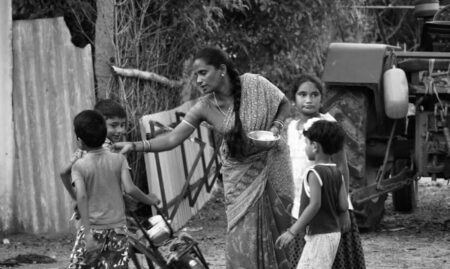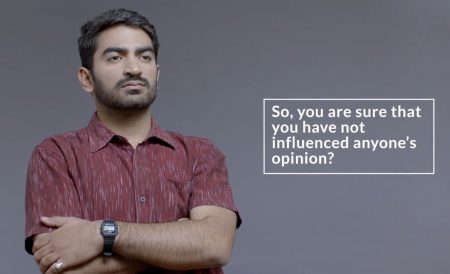I share a peculiar relationship with food: I’m afraid of it.
Or you could say that I have been made fearful of something most people love and fantasise about. This fear of food has been with me ever since I was a child, and society’s devious ways make sure that it continues to stay this way. I wonder if this feeling will ever go away.
What I wanted to know was, by calling her own food ‘pure’, what did she make of mine?
This so-called ‘shuddha shakahari’ or ‘pure veg’ written outside every other shop, what does it really mean? What is the criteria for purity, and how is it decided? My friend did not have answers to my questions. And ultimately, the thing that has repeatedly happened with the rest of my friendships happened again. Both — our conversations and our friendship — came to an end.
After this incident, my friend never spoke to me again. This wasn’t new to me. Ever since I can remember, I have heard and read this word ‘pure’ over and over again, and now I’m just tired of it. In fact, now someone says “pure”, and I can feel my blood boil. A deep restlessness surfaces.
I come from the khatik community. The people in my community work with meat.
I’ve been around meat ever since I was a child; you could say that our people don’t have an identity without it. I have seen pigs being raised, cut up, and sold. Other than pigs, we also cut and sell sheep, chicken, and fish. Looking back, my parents would always tell stories of how my father’s side of the family and his community — who migrated to from Pakistan’s Rawalpindi to Delhi during the Partition in 1947, all the way on foot — was given a vacant, secluded, jungle-like place to live in, by the government. Papa would tell me about the immense poverty he saw since he was a child. He had to start working at a very young age. My grandmother would go to the mandi and get fruits that were half-rotten. She would then get rid of the rotting parts, and sell them on the pavement. This is how we made ends meet. According to papa’s childhood anecdotes, he used to eat moldy roti cooked in pork fat.
My mother’s side of the family migrated from Uttar Pradesh to Haryana in search of work. There, my grandparents and my mother would work with pork. My mother would raise and sell piglets, and use the money for running the house.
Her anecdotes are full of dishes that use pork meat and fat. She talks about two with particular fondness – jhaai kutta and charbi wale paape. Both are absolutely delicious.
For preparing jhai kutta, flour and jaggery is mashed together by hand and then mixed in pork fat. It is a lot like besan ke laddoo, only tastier. To make charbi wale paape, we cook pork fat with milk and sugar over an open fire.
Jhai kutta and charbi ke pape are defining flavours of not just my mother’s life, but my life as well. As a child, during difficult times, I have also survived on weeks-old rotis cooked in pork fat, just like my father did. In my community, most food is cooked in pork fat, although this method is fast waning in popularity. I live in a cluster of homes, often called jhuggi jhopdi (a crude shelter or slum). People come by our homes and exclaim, “Arre, these people live near drains. They eat pig, chicken, fish and sheep.” In their eyes, we are dirty, and so is our food.
At school, I often hid my lunch because I was always taunted for it. Food was difficult to come by because we were poor, and when we did have something to eat, we were punished for it as if we had committed a crime. One day, I was sitting in class. Suddenly, a teacher entered and asked me, “You dark witch, what have you brought to eat today? Suar ki saanth (pig rind)?” Agitated, I retorted, “Why are you saying that? I don’t eat that stuff!” He then said, “I know what all you people eat, and what you don’t.” It wasn’t long before the entire class began laughing at me, while I started crying. The next evening, I spotted the very same teacher eating saanth near my house after school. I heard him direct the shopkeeper, “Give me fattier pieces of pork…” Listening to this made me want to fry his skin in hot oil, but anyway.
This is but a tiny glimpse. I have a bagful of stories carved into my being, my memories, my heart. I have been fighting this since childhood, but nothing has changed, even as an adult. I am still living these stories. The atmosphere is growing more tense each day. Let alone revealing my identity, it feels hard enough to even breathe. I often break down. I am in such mental anguish; the world often seems beyond my understanding.
People keep asking me,
“Where do you live? What is your surname? Why do you always bring meat for lunch, why not vegetables? What kind of meat have you prepared today? You must like eating with dirty hands, right?”
These are the central questions of my life that are glued to me through place and time; questions that people ask me without a moment of hesitation. This devious society may assume that caste-based discrimination should flow like water off a duck’s back, but not for me. Answering these questions is hard.
We have a dish called chhaatan. Have you heard about it? When a carcass is cut up, a few parts are leftovers; these are called chhaatan. This offal has more bone than meat, and consists of the animal’s heart, lungs, liver, and intestines; it is much cheaper than the other parts of meat. It is cooked in water and fat, or in very little oil. To put it simply, it is prepared like soup. The meatier parts of the animal are supplied to markets and hotels. Chhaatan, on the other hand, is taken back to our homes; it is both eaten and sold.
We cannot survive without pigs. Those with money have slaughterhouses, where meat is butchered and cleaned on a large scale. The people who work in these places belong to our community, while some of them are migrants from UP or Assam.
Another popular dish prepared in our homes is called gujji. We also call it ‘meat ka peda’. Pig and sheep intestines are cleaned, and then stuffed with keema (minced meat). It is then boiled and eaten.
The task of cleaning the intestines that are used for this dish is usually done by the girls and women of the house. The selling is always done by the men.
Gujji is one of those dishes, the taste and memory of which form an integral part of my life. We have grown up eating it. This is an essential part of our lives and livelihood — do we still have to hear everyone else’s ugly commentary on what food is pure?
Our dishes are shaped by poverty, and scarcity has given them form. All kinds of people visit our mohallas to get a taste of our food. The popularity of pan-fried pork is such that people travel great distances to eat it. The chhaatan I talked about plays a big role in the preparation of this dish. Every night, people arrive in their big cars — the very cars that have people’s last names painted on them to proclaim caste pride.

Actually, the tawa fry is relished at night mostly by those who make faces at us during the day.
There is a lot more that happens on these nights, but that is beyond the scope of this essay.
These different kinds of food are important to us not only as dishes that we enjoy; they also form the basis of our livelihood, our community, our identity, and our history. And history tells us that eating meat was not associated with caste identity. In the words of Babasaheb Ambedkar, “We cannot deny the fact that Hindus consumed cow meat in ancient times.” In his essay titled Achhoot Kaun Thay Aur Ve Achhoot Kaise Bane (Who Were the Untouchables and How Did They Become So), Babasaheb challenges the claim made by Hindus that they have always considered the cow holy and aghanya (something that cannot be eaten). To prove otherwise, Babasaheb relied on Hindu and Buddhist religious texts. Then why is it that the people of my community can be jailed and killed for eating their own food?
Our community’s sole means of livelihood is being destroyed.
Every day brings a new government order – some prohibit the sale of meat, some proclaim that it cannot be sold after a certain time at night, others order that meat shops be shut down during fasting days, prayers and festivals. Refusal to comply puts you in trouble. To instill fear, they threaten to make us vacate our homes, or just destroy our entire slum. One day, vehicle after vehicle was sent to obliterate the redi patris (our carts and lorries). They threw some of our stuff meant for sale, and took the rest. There is constant, high surveillance; anything can escalate into a thrashing at the police station. The people in my family who are meant to work with food, work with fear instead.
This is not the case for my community alone. Madhya Pradesh has posed restrictions on the sale of meat in the open. In Jharkhand, a man’s family was beaten up on the mere suspicion of selling cow meat. We come across such news everyday. There might be countless such incidents that never make it to mainstream news, that never get published.
Food-based discrimination has come home to roost in educational institutions as well. A prestigious college of Delhi University banned meat from its canteen. This order is still prevalent, despite resistance by students. Tables at IIT Bombay canteen have slips pasted with ‘Only vegetarians can sit here’ written on them. At a food festival in an all-women’s college in Karnataka, some women brought a chicken dish called koli kajjya, which ended up offending a lot of teachers, who then had it removed from display. The women repeatedly reminded them that about 90 percent of the students and people living on campus consume non-vegetarian food, and that this is a traditional dish, but it was to no avail. Moreover, they were threatened with punitive action if they refused to comply.
It is strange that while we celebrate ‘tradition’, some other people’s home-cooked traditional food becomes the reason for disciplinary action.
I wonder whose traditions are meant to be saved, then?
But the question is, who will compensate us for our mental anguish? Every moment feels worse than death. How will society account for this? They talk about protecting animals, but does human life hold no value? People belonging to Dalit, Adivasi, Muslim and other marginalised communities are subjected to worse treatment than animals. Who will take the responsibility for our protection?
The dishes that originated in our streets are very easily served in expensive, five star restaurants. All the burgers and pizzas by multinational chains that we are addicted to, are prepared with the meat of a pig, a cow or a chicken. But eating those dishes does not seem to corrupt anyone. The same food being cooked in our streets becomes a problem. It is called impure. Restrictions are placed in the name of hygiene.
Why is our work not considered work? I used to be afraid of these questions, but now I fight for the answers. There is a lot of anger inside me, and it’s increasing everyday. Is this just a question of food? Or is it a centuries-long practice to maintain and protect the structure of caste and hierarchy? I hold a lot of respect for my food. It is in its history that I find my existence and my identity. But at the same time, I am full of sorrow. There is immense anger within me. Is my sorrow, my anger meaningless?
Translated from the original Hindi piece by Pakhi Pande and Shabani Hassanwalia





